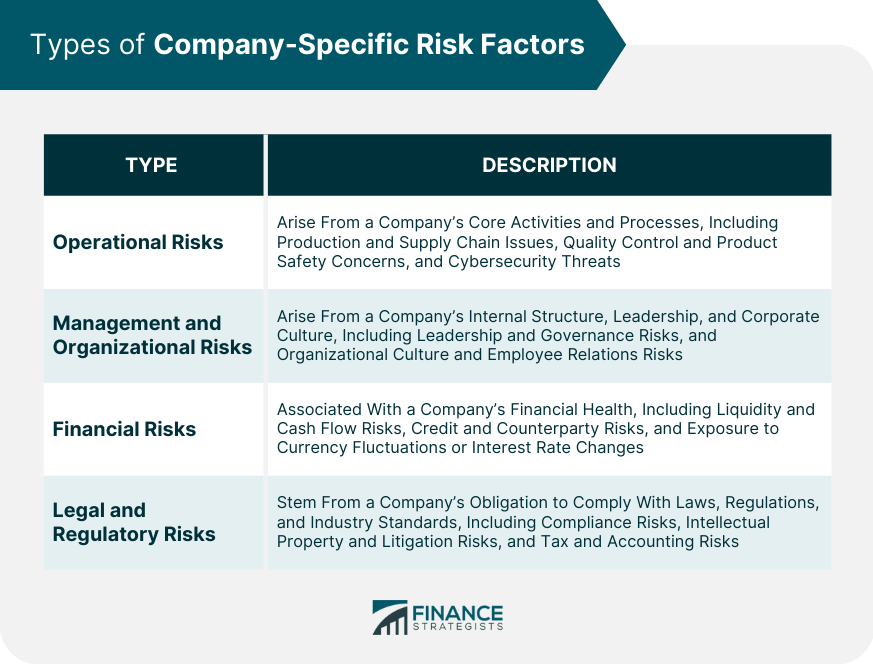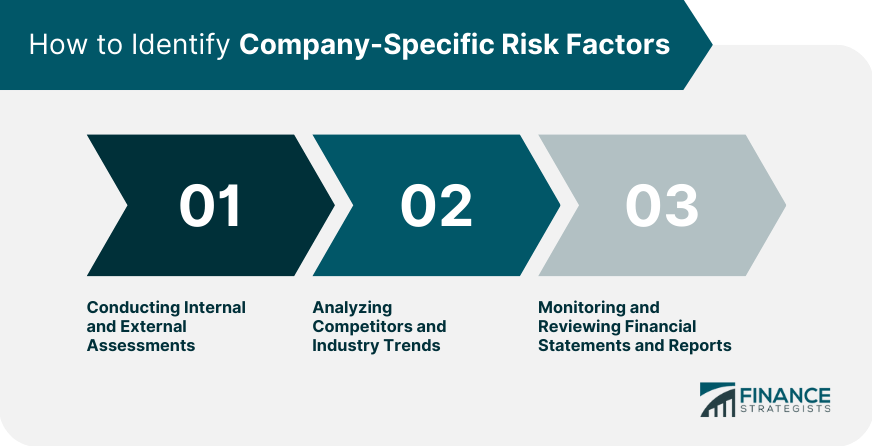Company-specific risk factors are unique to a particular organization and stem from internal or external sources. These risks are not correlated with market-wide fluctuations, making them potentially manageable through diversification. Understanding the specific risks that a company faces can help investors make informed decisions and businesses manage their exposure. Identifying and managing these risks can significantly impact a company's performance, valuation, and long-term success. Evaluating company-specific risk factors is crucial for businesses and investors alike. By identifying and managing these risks, organizations can protect their assets, minimize potential losses, and maximize shareholder value. For investors, a thorough understanding of company-specific risks is essential for making informed investment decisions. Recognizing and evaluating these risks can help investors select companies with a better risk-reward profile, enabling them to optimize their portfolios and minimize potential losses. Company-specific risk factors can have a significant impact on investment decisions, affecting stock prices, market valuations, and portfolio management strategies. Company-specific risks can influence stock prices and market valuations, as investors may adjust their expectations based on a company's risk exposure. Negative news or events related to company-specific risks can lead to declines in stock prices and reduced market capitalization. By understanding and managing these risks, businesses can maintain investor confidence and protect shareholder value, while investors can make informed decisions about their investments. Incorporating company-specific risk analysis into portfolio management strategies can help investors optimize their risk-reward profile. By assessing the risks associated with individual companies, investors can make informed decisions about their investments and adjust their portfolios accordingly. Diversifying investments across different companies, sectors, and asset classes can help mitigate the impact of company-specific risks, reducing the overall risk exposure of an investment portfolio. Diversification is a key strategy for managing company-specific risks in an investment portfolio. By spreading investments across a range of companies with varying risk profiles, investors can reduce the impact of individual risks on their overall portfolio performance. A well-diversified portfolio can help investors minimize potential losses from company-specific risks, while still capitalizing on the potential rewards associated with individual investments. This can lead to more stable returns and improved long-term performance. There are several types of company-specific risk factors that can affect a business, including operational, management and organizational, financial, and legal and regulatory risks. Understanding each type can help businesses and investors better assess potential hazards and manage their risk exposure. Operational risks arise from a company's core activities and processes. These risks can stem from various factors, including production issues, supply chain disruptions, and cybersecurity threats. Production and supply chain issues, such as equipment breakdowns or supplier delays, can negatively impact a company's ability to meet customer demand and maintain profitability. Quality control and product safety concerns can lead to reputational damage, product recalls, and legal liabilities, potentially affecting a company's long-term success. Management and organizational risks arise from a company's internal structure, leadership, and corporate culture. These risks can have a significant impact on a company's performance and long-term success. Leadership and governance risks stem from the quality of a company's management team, decision-making processes, and board oversight. Poor leadership can result in strategic missteps, employee turnover, and declining performance. Organizational culture and employee relations risks arise from the values, norms, and practices within a company. A toxic corporate culture can lead to high employee turnover, low morale, and reduced productivity. Financial risks are associated with a company's financial health, including cash flow, credit, and exposure to currency fluctuations or interest rate changes. Liquidity and cash flow risks arise from a company's ability to meet its short-term obligations and maintain sufficient cash reserves. Inadequate cash flow can result in operational disruptions, difficulty meeting debt obligations, and even bankruptcy. Credit and counterparty risks arise when a company or its trading partners face financial difficulties, potentially leading to losses or default. Legal and regulatory risks stem from a company's obligation to comply with laws, regulations, and industry standards, as well as potential exposure to litigation. Compliance with laws and regulations is crucial for maintaining a company's reputation and avoiding fines, penalties, or legal actions. Intellectual property and litigation risks involve potential legal disputes over patents, trademarks, copyrights, or other forms of intellectual property. Tax and accounting risks arise from a company's financial reporting and tax practices, which can have significant consequences if not properly managed. To effectively manage company-specific risk factors, businesses and investors must first identify the potential hazards they face. This involves conducting internal and external assessments, analyzing competitors and industry trends, and monitoring and reviewing financial statements and reports. Internal assessments involve evaluating a company's operations, management, financial health, and legal and regulatory compliance. This can help identify potential weaknesses and areas for improvement. External assessments involve examining the competitive landscape, industry trends, and macroeconomic factors that can impact a company's performance. By analyzing these factors, businesses and investors can identify potential threats and opportunities, helping them make informed decisions and develop effective risk management strategies. Keeping a close eye on competitors and industry trends can provide valuable insights into potential company-specific risks. By analyzing competitors' performance, strategies, and vulnerabilities, businesses can identify risks that might also apply to them and take proactive steps to mitigate those risks. Industry trends, such as technological advancements, regulatory changes, and shifts in consumer preferences, can also impact a company's performance. Monitoring these trends can help businesses and investors anticipate potential risks and capitalize on emerging opportunities. Regularly reviewing a company's financial statements and reports is crucial for identifying potential financial risks. Financial analysis can reveal issues with liquidity, cash flow, credit, and exposure to currency fluctuations or interest rate changes. By monitoring financial performance and identifying red flags, businesses and investors can take appropriate measures to manage their risk exposure and make informed decisions based on a company's financial health. Effectively managing company-specific risk factors involves implementing risk management frameworks, establishing clear policies and procedures, and ensuring effective communication and training. Developing and implementing a comprehensive risk management framework can help businesses identify, assess, and mitigate company-specific risks. This process involves setting risk management objectives, assigning responsibilities, and establishing processes for identifying, evaluating, and managing risks. By having a structured approach to risk management, businesses can better anticipate potential hazards, make informed decisions, and protect their assets and shareholder value. Clear policies and procedures can help businesses address and manage company-specific risks. These policies should outline the company's risk management objectives, responsibilities, and processes, ensuring that all employees understand their roles in managing risks. Regularly reviewing and updating these policies and procedures can help ensure that they remain effective in addressing emerging risks and changing circumstances. Effective communication and training are essential for managing company-specific risks. Employees should be well-informed about the company's risk management policies and procedures, as well as their individual responsibilities in mitigating risks. Training programs should be tailored to specific roles and responsibilities, ensuring that employees have the necessary skills and knowledge to effectively manage risks. Regular communication and updates on risk management initiatives can help maintain a strong risk management culture within the organization. Managing company-specific risk factors is critical for businesses and investors to protect their assets, maximize shareholder value, and make informed decisions. Continuous monitoring and evaluation of these risks can help organizations stay ahead of potential threats and capitalize on emerging opportunities. Balancing risk and reward in business decisions is essential for long-term success. By understanding and effectively managing company-specific risk factors, businesses and investors can better navigate the complex and ever-changing landscape of today's global economy.Definition of Company-Specific Risk Factors
Impact of Company-Specific Risk Factors on Investment Decisions
Effects on Stock Prices and Market Valuations
Incorporating Risk Analysis Into Portfolio Management
Diversifying Investments to Mitigate Risk Exposure
Types of Company-Specific Risk Factors
Operational Risks
Management and Organizational Risks
Financial Risks
Legal and Regulatory Risks

Identifying Company-Specific Risk Factors
Conducting Internal and External Assessments
Analyzing Competitors and Industry Trends
Monitoring and Reviewing Financial Statements and Reports

Managing Company-Specific Risk Factors
Implementing Risk Management Frameworks
Establishing Clear Policies and Procedures
Ensuring Effective Communication and Training
Conclusion
Company-Specific Risk Factors FAQs
Company-specific risk factors are risks that are unique to a particular company, such as management changes, financial instability, or product recalls.
Market risk factors affect the broader market or industry, while company-specific risk factors are unique to a specific company.
Some common types include financial risk, operational risk, legal and regulatory risk, and reputational risk.
Investors can manage company-specific risk factors by conducting thorough research, diversifying their portfolio, and monitoring their investments.
No, it's impossible to eliminate all company-specific risk factors. However, investors can take steps to minimize their exposure and protect their investments.
True Tamplin is a published author, public speaker, CEO of UpDigital, and founder of Finance Strategists.
True is a Certified Educator in Personal Finance (CEPF®), author of The Handy Financial Ratios Guide, a member of the Society for Advancing Business Editing and Writing, contributes to his financial education site, Finance Strategists, and has spoken to various financial communities such as the CFA Institute, as well as university students like his Alma mater, Biola University, where he received a bachelor of science in business and data analytics.
To learn more about True, visit his personal website or view his author profiles on Amazon, Nasdaq and Forbes.















